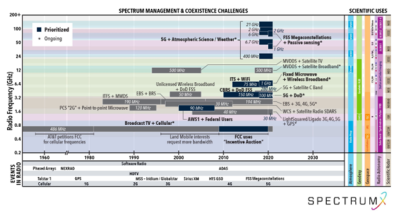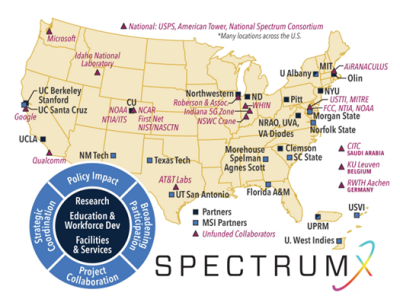Miguel Dajer and Timothy Jeffries
Published: 17 Nov 2023

CTN Issue: November 2023
Letter from the editor:
A Radio Spectrum Update on the Eve of the World Radiocommunications Conference (WRC)-2023 For the month of November CTN readers get a bonus article. We didn’t want to let WRC-23 slide by without providing a general overview of this important event which is starting this week in Dubai. With the growth of wireless services, spectrum management and availability has become of critical importance. Just this past week, the US Government issued a public document: the “U.S. National Spectrum Strategy” that discusses the USG efforts in terms of spectrum policy as a driver of societal equality and economic growth. Coincidentally or not, the document comes out just in time for WRC-23 and I encourage those interested in spectrum policies to read it. It is no secret that the future success of wireless based services is tied to the ability of governments to open new spectrum. In this article we provide a general overview of WRC-23 which we hope you find informative.
Miguel Dajer, CTN Editor-in-Chief
A Radio Spectrum Update on the Eve of the World Radiocommunications Conference (WRC)-2023


Spectrum is always a magical subject that most of us EM engineers have a hard time explaining to mere mortals. In the words of Heinrich Hertz who in 1890 said “I do not think that the wireless waves I have discovered will have any practical application” he cemented what a few years later would become the complete opposite, perhaps one of the most useful discoveries in mankind. Fast forward to 2023, the need for spectrum today is as pressing and critical as it has ever been, with so many applications and services clamoring for spectrum availability. With this backdrop, let’s discuss the state of spectrum and what WRC-2023 has in store.
State of Spectrum in the US
Each country has its own spectrum policies and strategies related to spectrum allocation so it would be rather difficult discussing the state of spectrum across all geographies. The United States has among the most congested spectrum in the world thanks to lots of legacy uses (particularly for the Department of Defense, and space science, and local public safety users) (Tricia Paoletta, 2023), as such it makes it a good candidate for this discussion.
Back in March of 2021, IEEE CTN published the article: The C Band Auction: What Just Happened? (Dajer, 2021) in which the author discussed at the time, the recently concluded C-band auction. With that auction, the US had set aside significant new spectrum to be used in the deployment of 5G technology. The article also argued that the purchase of Sprint by T-Mobile, in a sense, amounted to spectrum purchase for 5G, in that case 2.5GHz (Band 41) TDD spectrum. Along the way the US has also allocated spectrum for 5G in other bands including 600 MHz (Band 71) and Citizens Broadband Radio Service (CBRS) band 48 which is of particular interest to private cellular while also providing an interesting case study for future spectrum sharing due to the novel way in which it tries to utilize US Government owned spectrum for commercial use. CBRS and its success or not is precursor to 6G spectrum proposals that will be made at WRC-23 and eventually at WRC-27.
As we mentioned, the US has legacy spectrum that’s owned by government agencies or is assigned to activities other than wireless communications. Figure 1 provides a snapshot of these complexities, and because of these complexities, novel spectrum policies are needed to facilitate the use of this spectrum for commercial services. CBRS is one of these attempts, but we believe that more aggressive legislative policies are needed if the US (as an example Vs other countries) in order to free up sufficient “beach front” spectrum for advanced telecommunication services. Just in time for WRC-23, the USG has published “The National Spectrum Strategy” document which contains what the USG sees as spectrum priorities and policies for the future (USG, 2023).

A Bit About Spectrum X and Why Do We Care?
Figure 1 was taken from a presentation made by SpectrumX (Spectrum X, n.d.). Spectrum X is an NSF Spectrum Innovation Center which received a 5-year, $25M center award from the US National Science Foundation in 2021, and it is part of the new NSF Spectrum Innovation Initiative (SII). Currently 13 universities are part of this initiative, led by Notre Dame Wireless Institute with Nick Laneman as its director. Figure 2 shows the membership and the activities that Spectrum X is undertaking or will undertake in the upcoming years.

By now it is clear that Spectrum X is tasked to study trends and challenges related to radio spectrum. Persistent and intense demand for mid-band spectrum, move to higher frequencies in communications and how it encroaches on passive sensing (atmospheric measurements, radioastronomy, etc.), and defining access rights, conflict resolution and enforcement type strategies are some of the challenges that SpectrumX is trying to find and propose solutions for.
As we will see, the work in SpectrumX goes directly to the topics being discussed at the upcoming 2023 world radiocommunication conference and because of this, the work that SpectrumX is doing helps in establishing a set of priorities and potential solutions to the spectrum challenges in the US. Also, SpectrumX has collaborators in other countries (CITC in Saudi Arabia, KU Leuven in Belgium and RWTH Aachen in Germany to name a few), helping establish some consensus beyond the US borders.
ATIS Next G Alliance (NGA) and Its Spectrum Working Group (SGW)
The Alliance for Telecommunications Industry Solutions (ATIS), a US-based regional standards setting organization (SSO), in 2020 launched the Next Generation Alliance (NGA or NextG Alliance) to advance the next generation of wireless mobile services or 6G from a North America perspective. Comprising industry representatives, academia and government agencies, several working groups were established to meet this goal including, for the purpose of this article, the Spectrum Working Group. The ultimate goal of this group, set by NGA leadership, is to identify potential candidate bands for next generation mobile use and to, in part, contribute their regional insights to the International Telecommunications Union – Radiocommunication Sector (ITU-R) Study Group 5, Working Party 5D (WP 5D) in preparations for the upcoming WRC-23. The group also was tasked with looking into various potential spectrum sharing techniques and policies to maximize spectrum efficiency; but for this article, we will skip past discussing sharing techniques since they are mainly defined regionally and outside the scope of the ITU.
For this article, in terms of spectrum in preparation for WRC, members of the NGA have identified spectrum bands from both the mid-band and high-band with several potential bands subject to the upcoming WRC-23 for global designation and potential implementation. These bands include the 3.1 – 3.45 GHz, 4.4 – 5.0 GHz, and 10 - 10.5 GHz. For additional Candidate Spectrum Bands and other important information see the 6G-Spectrum-Considerations-rev1 whitepaper from the NGA SGW (SWG).
What is WRC and WRC-2023?
The following information is sourced from the ITU-R website which provides a roadmap to the upcoming work at working group 5 (Martin Fenton, 2023)
The World Radiocommunication Conference or WRC is an international treaty conference held every three to four years under the auspices of the ITU to review and revise the Radio Regulations which guide the global coordination, planning and implementation of radio-frequency spectrum and geostationary-satellite and non-geostationary-satellite orbits. The next WRC event is scheduled to be held in Dubai, United Arab Emirates, from November 20 to December 15, 2023 (ITU WRC 2023, 2023).
At the last WRC in 2019 (WRC-2019), spectrum for new mobile communications services (a.k.a. 5G) was allocated, enabling the rapid deployment of 5G globally. WRC has a very broad mandate, and its agenda reflects it. Of interest to us as it relates to this article are the aspects of WRC-2023 that relate to mobile communications (including satellite communications) as they are becoming more prevalent and integrated into commercial “cellular” networks (Martin Fenton, 2023).
Key Topics of Interest in WRC-2023
During the upcoming WRC-23, conference attendees – which are expected to exceed 3000 participants comprised of industry and government regulators from the 193 ITU member states – will come together to address a vast number of radio-regulation proposals (some 5000+) across ten pre-approved agenda items (AI). Of interest to us for this article, we focus on the agenda items for which the ITU-R, Working Party 5D, IMT Systems and Working Party 5A, Land mobile service (“fixed access”) excluding IMT, have undertaken in preparations for the conference and for which they were assigned primary responsibility.
Under the ITU construct, ITU-R Study Group 5 has 5 Working Parties (WP 5A – 5D) to oversee the preparatory work on terrestrial services that includes IMT, fixed wireless, and maritime services for the conference through dedicated groups of experts. WP 5D, IMT Systems oversee aspects of mid-band spectrum use, frequencies for unlicensed mobile applications, and other terrestrial services and applications, including modernizing and enhancing maritime emergency communications. WP 5A, oversees issues pertaining to land mobile service, excluding IMT, including wireless access in the fixed service. It also oversees amateur and amateur-satellite services.
“Mid-band” Spectrum
Mid-band spectrum spans several frequencies bands between 3 and 7 GHz. WRC‑23 is set to consider several agenda items (AI1.2 – AI1.4) related to the use of mid-band spectrum for mobile and wireless broadband connectivity. Much of the work is expected to center around new allocations of bands in this range but also on how to share the spectrum allocated for other services.
International Mobile Telecommunications (IMT) is the global standard created and maintained by the International Telecommunication Union (ITU) that specifies the requirements for mobile communication networks, including current 4G and fast-emerging 5G systems. IMT-2000, IMT- Advanced, and IMT-2020 are examples of IMT standards. The framework for future 6G systems also known as IMT‑2030 in ITU terms, will be discuss for ITU‑R adoption at the upcoming Study Group 5 meeting in September.
Upper 6 GHz — Unlicensed or IMT?
Just like licensed spectrum in general, demand for unlicensed spectrum continues to rise globally. Within the mid-band spectrum, the upper 6 GHz band is of particular interest for both Wi‑Fi and IMT type services (AI1.2). This spectrum covers the bands between 6.425 and 7.125 GHz with the majority of the countries in ITU Region 2 (comprising North and South America) already supporting this band for unlicensed use. The others, which include Brazil and Mexico, are aligned with China and other countries in supporting further study of the upper 6 GHz band at WRC-27.
WRC‑23 is set to consider this band up to 7.025 GHz for IMT use in Region 1 countries (Europe, Africa, the Commonwealth of Independent States, Mongolia, and the Middle East west of the Persian Gulf, including Iraq) and between 7.025 and 7.125 GHz globally. With such diverse interests on this spectrum, the work and outcome of these discussions at WRC-23 promises to be of great interest for lack of better word.
Other Terrestrial Services and Applications
Other agenda items for the crucial quadrennial conference include (Martin Fenton, 2023):
- Proposed measures to protect aeronautical and maritime mobile services in the frequency band 4800–4990 MHz for stations located in international airspace and waters (AI1.1)
- Use of high-altitude platform stations as IMT base stations (HIBS) in bands below 2700 MHz that are already identified for IMT (AI1.4)
- Regulatory provisions to enable sub-orbital vehicles to safely communicate with air traffic management systems and ground control facilities.
- Possibilities for allowing very-high frequency (VHF) aeronautical communications via non-geostationary satellites to standard VHF radios already installed onboard aircraft, particularly over oceans or other large remote areas not easily reachable with terrestrial systems.
- Provisions to allow unmanned aircraft (UA) to use fixed satellite service (FSS) networks and frequency allocations for control and non-payload communications (CNPC).
- Changes to the Radio Regulations (Appendix 27) that would allow digital technologies to use existing high-frequency (HF) bands (such as 2.85 MHz and 22 MHz) for safety-of-life applications on commercial aircraft.
- Potential new spectrum allocations (15.4 to 15.7 and 22 to 22.21 GHz) to the aeronautical mobile service for “non-safety” wideband line-of-sight data links.
Summary
Spectrum experts and regulators from around the world are descending on Dubai to begin discussion on how best to coordinate and harmonize the use of the world’s fleeting spectrum resource.
At hand, is the designation of IMT in the upper 6GHz spectrum band and government consensus on the use of other critically needed mid-band spectrum along with future spectrum designations and earth to space spectrum needs.
During the nearly month-long session, ITU member states will send the best of their best spectrum regulators and industry experts to enter into intense “horse-trading” sessions with other counties and regions all with the same goal of walking away with the best possible outcome to meet their market demands. How things will eventually end up, however, is still very much to-be-determined (TBD). In fact, despite the time and efforts since the last WRC four years ago, several regions are still trying to reach consensus on several bands and how, when and where to present their particular position on any given agenda item during the upcoming conference.
For those electing to monitor the conference, don’t expect to see any shoe throwing, open duels or fireworks. The conference will be all about strategy and watching it akin to watching a chess match. Most of the real discussions and eventual conclusions will take place behind doors during Head-of-Delegation (HOD) meetings with working group participants working to finalize the decisions reached.
Regardless, the conference and its conclusions are important as they will be used to set the world stage for the implementation of wireless terrestrial services. Keeping tabs on its progress and conclusions, as such, is worth a peek.
References
- Dajer, M. (2021, March). The C Band Auction: What Just Happened? IEEE CTN. Retrieved from https://www.comsoc.org/publications/ctn/c-band-auction-what-just-happened
- ITU WRC 2023. (2023). Retrieved from ITU: https://www.itu.int/wrc-23/
- Martin Fenton, C. I.‑R. (2023, august). Key topics for the terrestrial radio future. Retrieved from ITU: https://www.itu.int/hub/2023/08/key-topics-for-the-terrestrial-radio-future/
- Spectrum X. (n.d.). Retrieved from Spectrum X: https://www.spectrumx.org/
- SWG, N. (n.d.). Next G Alliance White Paper Spectrum Considerations. Retrieved from Next G Alliance: https://www.nextgalliance.org/wp-content/uploads/dlm_uploads/2023/08/6G-Spectrum-Considerations-rev1.pdf
- Tricia Paoletta, B. T. (2023). What’s At Stake for the U.S. at the World Radiocommunication Conference 2023? The Federalist Society.
- USG. (2023, November). NTIA. Retrieved from www.ntia.gov: https://www.ntia.gov/sites/default/files/publications/national_spectrum_strategy_final.pdf?source=email
Statements and opinions given in a work published by the IEEE or the IEEE Communications Society are the expressions of the author(s). Responsibility for the content of published articles rests upon the authors(s), not IEEE nor the IEEE Communications Society.


